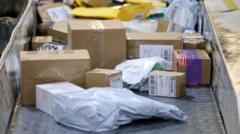A multi-country Salmonella outbreak in Europe linked to tomatoes from Italy has sickened more than 250 people. From January 2023 to November 2024, 266 confirmed cases of Salmonella Strathcona have been identified in 16 European countries and the United Kingdom. Croatia, Czech Republic, Denmark, Estonia, Finland, France, Ireland, Luxembourg, the… Continue Reading Foodborne Illness Outbreaks, World, 2024 outbreaks, European Centre for Disease Prevention and Control (ECDC), European Food Safety Authority (EFSA), Italy, Salmonella Strathcona, salmonellosis, tomatoes Food Safety News
A multi-country Salmonella outbreak in Europe linked to tomatoes from Italy has sickened more than 250 people.
From January 2023 to November 2024, 266 confirmed cases of Salmonella Strathcona have been identified in 16 European countries and the United Kingdom.
Croatia, Czech Republic, Denmark, Estonia, Finland, France, Ireland, Luxembourg, the Netherlands, Norway, Slovakia, Slovenia, and Sweden have also reported Salmonella Strathcona sequence type (ST) 2559 infections. Among 197 cases with age and gender data available, females were more affected than males.
An assessment by the European Centre for Disease Prevention and Control (ECDC) and European Food Safety Authority (EFSA) said tomatoes were the vehicle of infection in several national epidemiological investigations undertaken in response to the multi-country outbreak.
Italy has the most cases, with 67, followed by Germany with 62, Austria with 33, and France with 23. There are 29 infections in the UK, and Canada reported five cases among travelers to Europe in 2023 and 2024.
Italian situation
From late September to early October 2024, Tuscany and Umbria in Italy reported Salmonella outbreaks with 46 Salmonella Strathcona cases and nine Salmonella Strathcona ST2559 clinical isolates currently confirmed.
In the Tuscany region, 248 cases of gastroenteritis, 93 confirmed as salmonellosis and 14 as Salmonella Strathcona, affecting 240 children aged 1 to 10, seven food workers, and one teacher in 39 schools, were identified, with exposure to meals prepared at a single cooking center.
In Umbria, 63 cases of salmonellosis, including 32 of Salmonella Strathcona and nine of Salmonella Strathcona ST2559, were identified at education establishments that shared a cooking center and the staff working for it. Salmonella Strathcona was detected from spelt with tomatoes and pesto. Suspected cherry tomatoes were traced back to three Italian wholesalers and two producers.
The Italian food safety authority is undertaking sampling involving collecting and testing cherry tomatoes on the national Salmonella market, focusing on the suspected Sicily region. This will be completed by the end of December 2024.
An outbreak investigation in Austria in 2023 identified organic cherry tomatoes from one supermarket as the suspected vehicle based on a food donation that one patient received before the illness.
Secondary transmission was reported in one laying hen farm operated by a person who fell ill with a Salmonella Strathcona ST2559 infection in November 2023. As of October 2024, three flocks and one batch of eggs have tested positive for Salmonella Strathcona.
Historical outbreak link
The UK has 29 cases of Salmonella Strathcona ST2559, with sample dates between 2023 and 2024. The sick people are aged under 1 to 76 and include 17 females and 12 males.
Information from patient interviews in Austria, Czech Republic, Denmark, Germany, France, Ireland, Italy, Luxembourg, and Sweden showed that 64 of 90 patients reported consuming tomatoes, and 42 of 64 mentioned small or cherry tomatoes.
Of 11 non-human isolates submitted to EFSA’s WGS system, one was from bovine feces collected in Sicily in 2023.
Epidemiological, microbiological, and traceability investigations in the 2023 Austrian and 2024 Italian outbreaks confirmed that small tomatoes from the Sicily region were the vehicle of infection. The same conclusion was made for a Salmonella Strathcona outbreak in Denmark in 2011.
The outbreak strain has been circulating in Europe since 2011 when Denmark reported a large multi-country outbreak. Small, elongated datterino tomatoes traded from Sicily were identified as the source of infections. In 2020, Denmark noted a re-emergence of the same Salmonella Strathcona strain with 26 sick and snack tomatoes as the suspected vehicle of infection.
The 2011 outbreak strain is genetically similar to the current outbreak strain. In 2024, authorities in Italy investigated and indicated that tomatoes implicated in the 2011 and 2023 events may have originated from the same region, but no common producers were identified.
“The environment’s role in the contamination of the tomatoes should also be investigated, as the outbreak strain was also identified in a farm animal in the region. Investigations to identify the point of entry of Salmonella Strathcona – including irrigation water – should be conducted so the appropriate corrective measures are taken to stop the contamination from spreading and to prevent possible new cases,” said ECDC.
(To sign up for a free subscription to Food Safety News, click here.)








